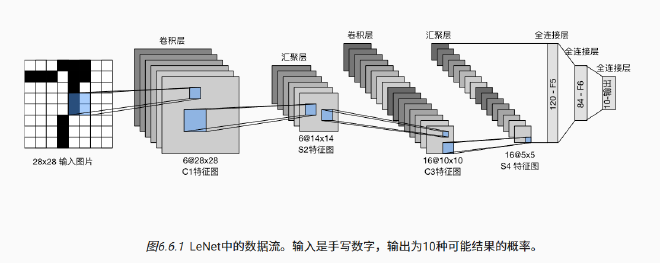Last Edit: 3/31/25
我们在前面章节已经学习了构建完整 Convolutional Neural Network 卷积神经网络,简称 CNN)所需的基础模块,但是为了把这些模块真正用起来,需要介绍一个完整的、早期的 CNN 架构 LeNet(LeNet-5)
6.6.1 LeNet#

| 层 | 输出形状 |
|---|---|
| 输入 | 1 × 28 × 28 |
| C1 卷积 | 6 × 28 × 28 |
| S2 池化 | 6 × 14 × 14 |
| C3 卷积 | 16 × 10 × 10 |
| S4 池化 | 16 × 5 × 5 |
| 展平后 | 400(向量) |
| FC1 | 120 |
| FC2 | 84 |
| 输出 | 10(分类概率) |
- 每一个 Convolution Layer 包含一个 5x5 Kernel,一个 Sigmoid Activation Function,同时也在增加 Output Channel,而每一个 Pooling Layer 都通过 2x2 的 window 和 2 的 Stride 将宽高减半
- 其中在 Convolution Layer 和 Full-Connect Layer 中需要进行数据的 Flatten 因为 Full-Connect Layer 只接受一维向量之后送进全连接
- 最后保留 10 维的输出,对应了 LeNet 的分类 0-9 任务
- 通过一个简单的 Sequential 块就可以实现 LeNet
import torch
from torch import nn
from d2l import torch as d2l
# 使用 nn.Sequential 顺序堆叠每一层,构建 LeNet 网络
net = nn.Sequential(
# 第一层:卷积层
# 输入通道数 1(灰度图),输出通道数 6,卷积核大小 5×5,padding=2 保持输出大小不变
nn.Conv2d(1, 6, kernel_size=5, padding=2),
nn.Sigmoid(), # 激活函数使用 sigmoid(原始 LeNet 使用的激活)
# 第一层:平均池化层,窗口 2×2,步幅 2(尺寸减半)
nn.AvgPool2d(kernel_size=2, stride=2),
# 第二层:卷积层
# 输入通道数 6,输出通道数 16,卷积核大小 5×5,不使用 padding(输出会缩小)
nn.Conv2d(6, 16, kernel_size=5),
nn.Sigmoid(),
# 第二层:平均池化层
nn.AvgPool2d(kernel_size=2, stride=2),
# 将卷积输出展平为一维向量,便于输入到全连接层
nn.Flatten(),
# 第一层全连接:输入 16×5×5 = 400 个节点,输出 120 个神经元
nn.Linear(16 * 5 * 5, 120),
nn.Sigmoid(),
# 第二层全连接:120 → 84
nn.Linear(120, 84),
nn.Sigmoid(),
# 第三层全连接(输出层):84 → 10(10 类分类结果)
nn.Linear(84, 10)
)
- 简单概括就是图像尺寸越来越小,但是通道越来越多
6.6.2 Model Train#
- 为了使用 GPU,需要作出一些小的改动
def evaluate_accuracy_gpu(net, data_iter, device=None):#@save"""使用GPU计算模型在数据集上的精度"""if isinstance(net, nn.Module):
net.eval()# 设置为评估模式ifnot device:
device = next(iter(net.parameters())).device
# 正确预测的数量,总预测的数量metric = d2l.Accumulator(2)
with torch.no_grad():
for X, yin data_iter:
if isinstance(X, list):
# BERT微调所需的(之后将介绍)X = [x.to(device)for xin X]
else:
X = X.to(device)
y = y.to(device)
metric.add(d2l.accuracy(net(X), y), y.numel())
return metric[0] / metric[1]
- 接下来就是主训练函数
定义函数#
def train_ch6(net, train_iter, test_iter, num_epochs, lr, device):
"""用 GPU 训练模型(在第六章定义)"""
1️⃣ 初始化网络参数(使用 Xavier 初始化)#
def init_weights(m):
if type(m) == nn.Linear or type(m) == nn.Conv2d:
nn.init.xavier_uniform_(m.weight)
net.apply(init_weights)
- 对所有
Linear和Conv2d层使用 Xavier 均匀初始化,其他层是没有参数的,不用管
2️⃣ 设置设备(GPU / CPU)和优化器#
print('training on', device)
net.to(device)
optimizer = torch.optim.SGD(net.parameters(), lr=lr)
loss = nn.CrossEntropyLoss()
- 使用随机梯度下降(SGD)
- 使用 Cross Entropy Loss
3️⃣ 可视化工具(绘图)#
animator = d2l.Animator(...)
4️⃣ 开始训练循环#
for epoch in range(num_epochs):
① 初始化指标收集器(loss、acc、样本数)#
metric = d2l.Accumulator(3) # D2L 库的累加器
② 设置模型为训练模式#
net.train()
③ 遍历每个 batch#
for i, (X, y) in enumerate(train_iter):
- 将数据移到设备上(X 和 y)
- 前向传播 → 计算损失 → 反向传播 → 梯度更新
timer.start() #开始计时
optimizer.zero_grad() #重置梯度
X, y = X.to(device), y.to(device)
y_hat = net(X) #前面的 nn.Sequence 的输出值
l = loss(y_hat, y) #Loss
l.backward() #Feed Backward
optimizer.step() #Optimizer
with torch.no_grad():
#添加值到前面的定义的累加器中
metric.add(l * X.shape[0], d2l.accuracy(y_hat, y), X.shape[0])
timer.stop() #结束计时
train_l = metric[0] / metric[2]
train_acc = metric[1] / metric[2]
④ 每训练完一部分,更新动态图(绘图)#
if (i + 1) % (num_batches // 5) == 0 or i == num_batches - 1:
animator.add(...)
5️⃣ 每轮结束后在测试集上评估#
test_acc = evaluate_accuracy_gpu(net, test_iter)
animator.add(...)
6️⃣ 最终打印结果#
print(f'loss {train_l:.3f}, train acc {train_acc:.3f}, test acc {test_acc:.3f}')
print(f'{metric[2] * num_epochs / timer.sum():.1f} examples/sec on {str(device)}')